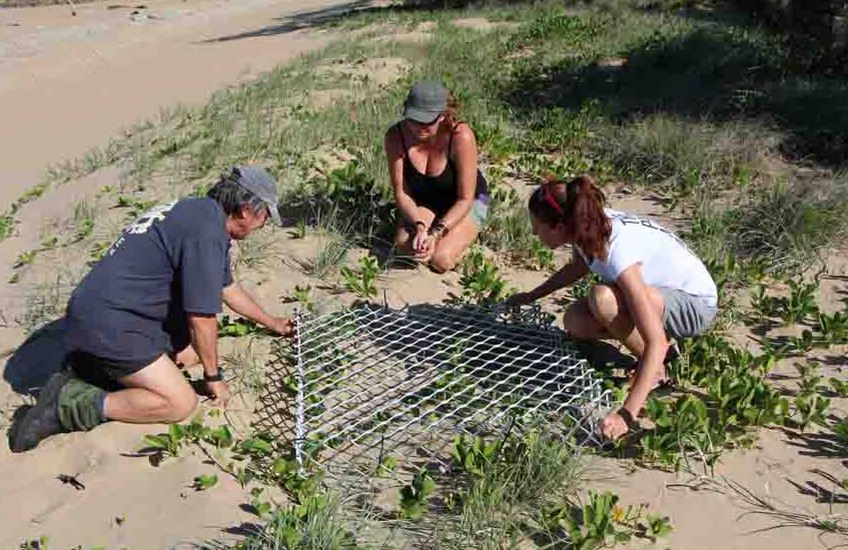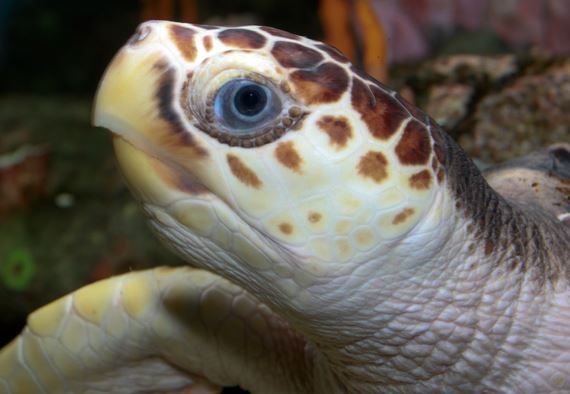Loggerhead sea turtles nests are being destroyed by goannas that are eating thousands of eggs and hatchlings at Wreck Rock Beach, between Bundaberg and Gladstone on the Queensland coast in Australia. Researchers are trying out excluder devices and deterrents, including red flags and pepper, to protect the nests.
According to the World Wildlife Fund Australia, over seventy endangered female loggerhead sea turtles (loggerheads) nest at Wreck Rock Beach each year. The area is the South Pacific Ocean’s second largest mainland nesting site for loggerheads.
The loggerheads’ greatest problem used to be foxes, but baiting significantly reduced their impact on nests. Now goannas (a type of Australian monitor lizard) have replaced foxes as the problem.

Experts are concerned that the native lizards could be seriously undermining the endangered species chances of surviving in the area.
Aluminium cages too cumbersome for the long term
In 2014, WWF-Australia backed a trial of aluminium cages placed over the loggerhead nests to keep the lizards out. The trial managed to save about 1,200 hatchlings. However, each device takes about 20 minutes to install, which for a small dedicated group is not a practical long-term plan at a high density nesting beach.
The University of Queensland is now leading a new, 2-year research project to trial more user-friendly deterrents and devices, and also to gain more insight into the predatory habits of goannas.
Turtle Care, the Burnett Mary Regional Group, Gidarjil rangers and WWF-Australia are assisting the project, which received nearly $180,000 in funding through the Nest to Ocean Turtle Protection Program, a joint initiative by the Australian and Queensland Governments to combat predation of turtle nests.

Dr. David Booth, a University of Queensland Scientist, said he and his team are learning more about goanna behaviour.
Main culprit yellow spotted goannas
Dr. Booth said:
“It appears that larger yellow spotted goannas are the first to attack a nest because they have the strength and persistence to dig down through the sand. Once there’s a tunnel to the eggs, smaller yellow spotted goannas and lace monitors also try for an easy meal.”
“GPS tracking indicates that yellow spotted goannas are the main culprit. They spend much more time among the beach dunes than lace monitors and no camera trap has ever shown a lace monitor initiating an attack on a nest.”
“If we find that a few large yellow spotted goannas are responsible for the majority of nest predation, then relocating these individuals could mean thousands more baby turtles have a chance at life.”
Pepper and flags appear to work
According to Dr. Booth, spreading pepper over nests helped keep predators away in other countries, as has using flags that flap in the breeze – apparently the flapping spooks predators.

Dr. Booth said:
“Unfortunately, initial testing at Wreck Rock Beach has shown that pepper and flags are not particularly successful against goannas. But a simple piece of plastic mesh is proving much more promising.”
“It’s lighter and much easier to transport and install than the aluminium cage and if it is set up properly on top of a nest and covered in sand it is effective at stopping goannas.”
According to Christine Hof, a spokesperson for WWF-Australia, globally loggerheads are endangered mainly because they get tangled in fishing gear, are struck by boats, ingest marine debris, and predation.
Ms. Hof said:
“In Australia, turtle exclusion devices on nets and fox baiting has eased those problems but now goannas have emerged as a serious issue at the important nesting site of Wreck Rock Beach.”
“A healthy Great Barrier Reef needs healthy populations of marine turtles. Helping loggerheads and other marine turtle species recover is a top priority for WWF.”
Nev and Bev McLachlan, long-term volunteers from Turtle Care, have become increasingly concerned about the number of nests destroyed by goannas.
Bev McLachlan said:
“Our main concern is that something must be done to decrease the amount of predation on our beach so that these beautiful sea creatures are around for all to see.”
Saranne Giudice, from the Burnett Mary Regional Group said:
“Visitors to Wreck Rock may see goannas that are part of the research project marked with numbers or a GPS device, however these do not stay on the animals for long and are not harmful.
“Our region has a crucial role as guardians of a major nesting site for endangered loggerheads. We’ll keep working hard with our partners to give these magnificent creatures a chance to survive into the future.”
